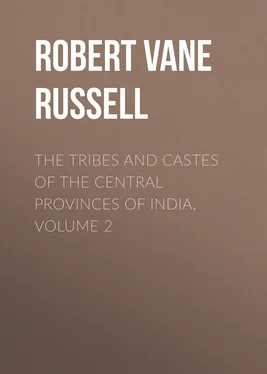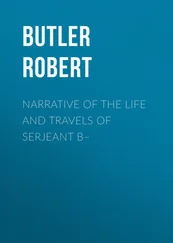Robert Vane Russell - The Tribes and Castes of the Central Provinces of India, Volume 2
Здесь есть возможность читать онлайн «Robert Vane Russell - The Tribes and Castes of the Central Provinces of India, Volume 2» — ознакомительный отрывок электронной книги совершенно бесплатно, а после прочтения отрывка купить полную версию. В некоторых случаях можно слушать аудио, скачать через торрент в формате fb2 и присутствует краткое содержание. Жанр: foreign_prose, История, foreign_edu, foreign_antique, на английском языке. Описание произведения, (предисловие) а так же отзывы посетителей доступны на портале библиотеки ЛибКат.
- Название:The Tribes and Castes of the Central Provinces of India, Volume 2
- Автор:
- Жанр:
- Год:неизвестен
- ISBN:нет данных
- Рейтинг книги:4 / 5. Голосов: 1
-
Избранное:Добавить в избранное
- Отзывы:
-
Ваша оценка:
- 80
- 1
- 2
- 3
- 4
- 5
The Tribes and Castes of the Central Provinces of India, Volume 2: краткое содержание, описание и аннотация
Предлагаем к чтению аннотацию, описание, краткое содержание или предисловие (зависит от того, что написал сам автор книги «The Tribes and Castes of the Central Provinces of India, Volume 2»). Если вы не нашли необходимую информацию о книге — напишите в комментариях, мы постараемся отыскать её.
The Tribes and Castes of the Central Provinces of India, Volume 2 — читать онлайн ознакомительный отрывок
Ниже представлен текст книги, разбитый по страницам. Система сохранения места последней прочитанной страницы, позволяет с удобством читать онлайн бесплатно книгу «The Tribes and Castes of the Central Provinces of India, Volume 2», без необходимости каждый раз заново искать на чём Вы остановились. Поставьте закладку, и сможете в любой момент перейти на страницу, на которой закончили чтение.
Интервал:
Закладка:
4. Further instances of dacoities.
Colonel Sleeman writes elsewhere 46 46 Sleeman, p. 231.
of the leader of the above exploit: “This Gajrāj had risen from the vocation of a bandarwāla (monkey showman) to be the Robin Hood of Gwālior and the adjacent States; he was the governor-general of banditti in that country of banditti and kept the whole in awe; he had made himself so formidable that the Durbar appointed him to keep the ghāts or ferries over the Chambal, which he did in a very profitable manner to them and to himself, and none entered or quitted the country without paying blackmail.” A common practice of the Badhaks, when in need of a little ready money, was to lie in wait for money-changers on their return from the markets. These men take their bags of money with them to the important bazārs at a distance from their residence and return home with them after dusk. The dacoits were accustomed to watch for them in the darkest and most retired places on the roads and fell them to the ground with their bludgeons. This device was often practised and usually succeeded. 47 47 Sleeman, p. 217.
Of another Badhak chief, Meherbān, it is stated 48 48 Sleeman, p. 20.
that he hired a discharged sepoy to instruct his followers in the European system of drill, that they might travel with him in the disguise of regular soldiers, well armed and accoutred. During the rains Meherbān’s spies ( hirrowa ) were sent to visit the great commercial towns and report any despatches of money or other valuables, which were to take place during the following open season. His own favourite disguise was that of a Hindu prince, while the remainder of the gang constituted his retinue and escort. On one occasion, assuming this character, he followed up a boat laden with Spanish dollars which was being sent from Calcutta to Benāres; and having attacked it at its moorings at Makrai, he killed one and wounded ten men of the guard and made off with 25,000 Spanish dollars and Rs. 2600 of the Company’s coinage. A part of the band were sent direct to the rendezvous previously arranged, while Meherbān returned to the grove where he had left his women and proceeded with them in a more leisurely fashion to the same place. Retaining the character of a native prince he halted here for two days to celebrate the Holi festival. Marching thence with his women conveyed in covered litters by hired bearers who were changed at intervals, he proceeded to his bivouac in the Oudh forests; and at Seosāgar, one of his halting-places, he gave a large sum of money to a gardener to plant a grove of mango trees near a tank for the benefit of travellers, in the name of Rāja Meherbān Singh of Gaur in Oudh; and promised him further alms on future occasions of pilgrimage if he found the work progressing well, saying that it was a great shame that travellers should be compelled as he had been to halt without shade for themselves or their families during the heat of the day. He arrived safely at his quarters in the forest and was received in the customary fashion by a procession of women in their best attire, who conducted him with dancing and music, like a victorious Roman Proconsul, to his fort. 49 49 Sleeman, p. 21.
5. Disguise of religious mendicants.
But naturally not all the Badhaks could do things in the style of Meherbān Singh. The disguise which they most often assumed in the north was that of carriers of Ganges water, while in Central India they often pretended to be Banjāras travelling with pack-bullocks, or pilgrims, or wedding-parties going to fetch the bride or bridegroom. Sometimes also they took the character of religious mendicants, the leader being the high priest and all the rest his followers and disciples. One such gang, described by Colonel Sleeman, 50 50 Sleeman, p. 81.
had four or five tents of white and dyed cloth, two or three pairs of nakkāras or kettle-drums and trumpets, with a great number of buffaloes, cows, goats, sheep and ponies. Some were clothed, but the bodies of the greater part were covered with nothing but ashes, paint and a small cloth waistband. But they always provided themselves with five or six real Bairāgis, whose services they purchased at a very high price. These men were put forward to answer questions in case of difficulty and to bully the landlords and peasantry; and if the people demurred to the demands of the Badhaks, to intimidate them by tricks calculated to play upon the fears of the ignorant. They held in their hands a preparation of gunpowder resembling common ashes; and when they found the people very stubborn they repeated their mantras over this and threw it upon the thatch of the nearest house, to which it set fire. The explosion was caused by a kind of fusee held in the hand which the people could not see, and taking it for a miracle they paid all that was demanded. Another method was to pretend to be carrying the bones of dead relatives to the Ganges. The bones or ashes of the deceased, says 51 51 Sleeman, p. 82.
Colonel Sleeman, are carried to the Ganges in bags, coloured red for females and white for males. These bags are considered holy, and are not allowed to touch the ground upon the way, and during halts in the journey are placed on poles or triangles. The carriers are regarded with respect as persons engaged upon a pious duty, and seldom questioned on the road. When a gang assumed this disguise they proceeded to their place of rendezvous in small parties, some with red and some with white bags, in which they carried the bones of animals most resembling those of the human frame. These were supported on triangles formed of the shafts on which the spear-heads would be fitted when they reached their destination and had prepared for action.
6. Countenance and support of landowners.
It would have been impossible for the Badhaks to exist and flourish as they did without the protection of the landowners on whose estates they lived; and this they received in full measure in return for a liberal share of their booty. When the chief of Karauli was called upon to dislodge a gang within his territory, he expressed apprehension that the coercion of the Badhaks might cause a revolution in the State. He was not at all singular, says Colonel Sleeman, in his fear of exasperating this formidable tribe of robbers. It was common to all the smaller chiefs and the provincial governors of the larger ones. They everywhere protected and fostered the Badhaks, as did the landholders; and the highest of them associated with the leaders of gangs on terms of equality and confidence. It was very common for a chief or the governor of a district in times of great difficulty and personal danger to require from one of the leaders of such gangs a night-guard or palang ki chauki : and no less so to entertain large bodies of them in the attack and defence of forts and camps whenever unusual courage and skill were required. The son of the Rāja of Charda exchanged turbans with a Badhak leader, Mangal Singh, as a mark of the most intimate friendship. This episode recalls an alliance of similar character in Lorna Doone ; and indeed it would not be difficult to find several points of resemblance between the careers of the more enterprising Badhak leaders and the Doones of Bagworthy; but India produced no character on the model of John Ridd, and it was reserved for an Englishman, Colonel Sleeman, to achieve the suppression of the Badhaks as well as that of the Thugs. After the fortress and territory of Garhākota in Saugor had been taken by the Mahārāja Sindhia, Zālim Singh, a cousin of the dispossessed Bundela chief, collected a force of Bundelas and Pindāris and ravaged the country round Garhākota in 1813. In the course of his raid he sacked and burnt the town of Deori, and 15,000 persons perished in the flames. Colonel Jean Baptiste, Sindhia’s general, obtained a number of picked Badhaks from Rājputāna and offered them a rich reward for the head of Zālim Singh; and after watching his camp for three months they managed to come on him asleep in the tent of a dancing-girl, who was following his camp, and stabbed him to the heart. For this deed they received Rs. 20,000 from Baptiste with other valuable presents. Their reputation was indeed such that they were frequently employed at this period both by chiefs who desired to take the lives of others and by those who were anxious for the preservation of their own. When it happened that a gang was caught after a robbery in a native State, the custom was not infrequently to make them over to the merchant whose property they had taken, with permission to keep them in confinement until they should refund his money; and in this manner by giving up the whole or a part of the proceeds of their robbery they were enabled to regain their liberty. Even if they were sent before the courts, justice was at that time so corrupt as to permit of easy avenues of escape for those who could afford to pay; and Colonel Sleeman records the deposition of a Badhak describing their methods of bribery: “When police officers arrest Badhaks their old women get round them and give them large sums of money; and they either release them or get their depositions so written that their release shall be ordered by the magistrates. If they are brought to court, their old women, dressed in rags, follow them at a distance of three or four miles with a thousand or two thousand rupees upon ponies; and these rupees they distribute among the native officers of the court and get the Badhaks released. These old women first ascertain from the people of the villages who are the Nāzirs and Munshis of influence, and wait upon them at their houses and make their bargains. If the officials cannot effect their release, they take money from the old women and send them off to the Sadar Court, with letters of introduction to their friends, and advice as to the rate they shall pay to each according to his supposed influence. This is the way that all our leaders get released, and hardly any but useless men are left in confinement.” 52 52 Sleeman, p. 152.
Интервал:
Закладка:
Похожие книги на «The Tribes and Castes of the Central Provinces of India, Volume 2»
Представляем Вашему вниманию похожие книги на «The Tribes and Castes of the Central Provinces of India, Volume 2» списком для выбора. Мы отобрали схожую по названию и смыслу литературу в надежде предоставить читателям больше вариантов отыскать новые, интересные, ещё непрочитанные произведения.
Обсуждение, отзывы о книге «The Tribes and Castes of the Central Provinces of India, Volume 2» и просто собственные мнения читателей. Оставьте ваши комментарии, напишите, что Вы думаете о произведении, его смысле или главных героях. Укажите что конкретно понравилось, а что нет, и почему Вы так считаете.












